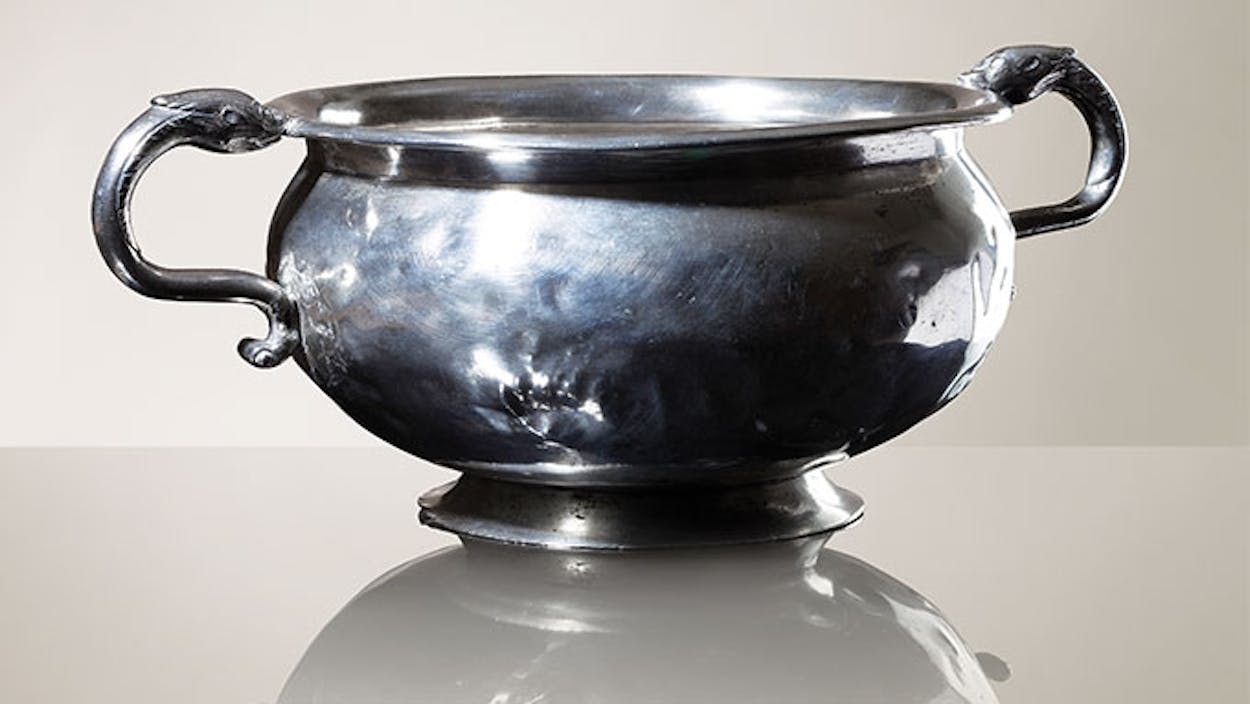The day after Antonio López de Santa Anna’s crushing defeat at San Jacinto, he was captured by a Texas cavalry patrol that was rounding up the remnants of his army. The Mexican general, who was disguised as a common soldier, was taken to Sam Houston, who was lying on a blanket under an oak tree, his ankle shattered by a bullet. A negotiation took place between Houston, Santa Anna, and Texas secretary of war Thomas Jefferson Rusk, in which Rusk asked Santa Anna to write out orders instructing the part of his army that had not been defeated at San Jacinto to withdraw from Texas.
Santa Anna agreed and sent his personal secretary, Ramon Caro, back to his tent to bring his portable writing desk and personal stationery so that he could write the orders. Caro also had Santa Anna’s bed and a chest containing some of his personal belongings brought to where Houston was lying, and eventually his tent was moved and pitched near Houston’s. For the next few nights the Mexican general slept in his own bed while Houston and the rest of the Texas army slept, as was customary, on the ground. This did not sit well with the Texans, many of whom wanted to execute Santa Anna on the spot.
Because the battlefield was covered with the rotting corpses of Mexican soldiers and the stench was unbearable, a few days after the battle the Texas army and their prisoners moved their camp to a nearby plantation owned by Dr. George Patrick. There, on April 26, 1836, the Texans held what came to be known as the booty auction. First, the Mexican army’s treasury, which consisted of about $12,000 in silver pesos, was divided among the soldiers, with each man receiving about $9, which many of them turned around and spent on the vast store of captured Mexican supplies and livestock. The bidding was lively, and the soldiers bought muskets, saddles, blankets, spurs, horses, and mules. The items auctioned off also included some of Santa Anna’s personal belongings, taken from his camp chest. Houston did not participate in the auction, but several of his fellow officers went in together and bought Santa Anna’s bridle and saddle with gold stirrups for $800 and presented them to Houston. According to historian Stephen L. Moore, Adjutant General John Wharton bought $400 worth of goods for Houston. The documentary evidence of the auction strongly suggests that someone, possibly Wharton, also bought the Mexican general’s silver chamber pot and presented it to Houston as a joke.
The vessel, known in Spanish as a bacinica, is eight inches in diameter and four and a half inches deep. Its two ornate handles terminate in serpentine heads, their lips touching its rim. The hallmarks stamped into its base show that it was made in Mexico City in the late 1820’s or early 1830’s by master silversmith José María Martinez. Chamber pots were usually ceramic (or perhaps made of tinware if expected to travel); they were the most utilitarian type of utensil, a container kept in bedrooms in the days before indoor plumbing to answer nocturnal calls of nature. A silver chamber pot was distinctly over the top. But then its owner was also over the top. Santa Anna was a man of overweening ambition and immense vanity. Historians have described his gaudy marquee and the canopied camp bed, silk sheets, silver dishes, and crystal stemware that adorned its interior. One of his officers on the Texas campaign, Captain José Enrique de la Peña, commented that Santa Anna traveled “more as a prince than as a republican leader.” After his capture, Santa Anna described himself to Houston as “the Napoleon of the West.” And in fact, Napoleon Bonaparte’s brother, Joseph Bonaparte, the king of Spain from 1808 to 1813, had a silver chamber pot that was captured by the British 14th Light Dragoons at the Battle of Vitoria in 1813 and is still among their regimental silver. If the king of Spain went on campaign with a silver chamber pot, why shouldn’t Santa Anna?
Sam Houston never mentioned the chamber pot in any of his surviving correspondence, nor is it noted by any of his biographers. Houston was a man who stood on his dignity. He was noted for his withering sarcasm but not for his sense of humor. It may be that he thought the gift undignified, or it may be that he privately relished its symbolism but thought it not worthy of public comment. The historical record is silent here.
Today the chamber pot is in the Sam Houston Memorial Museum, in Huntsville. It was donated to the museum in 1935 by Sam Houston’s son Colonel Andrew Jackson Houston, who was then 81 years old. Like his father, Andrew Houston appears to have been less than eager to broadcast the true nature of his family’s trophy, which is how it ended up with its second handle. Most chamber pots have only one handle, but the vessel in the museum’s collection has two. In a letter in the museum’s files written in 1951, one of Sam Houston’s grandchildren, Temple Houston Morrow, explains that his uncle Andrew was so modest that he added the extra handle to the pot and told people it was a soup tureen. That is how it was accessioned into the collection.
Sam Houston Memorial Museum, 1836 Sam Houston Ave., Huntsville (936-294-1832). Open Tue–Sat 9–4:30, Sun noon–4:30.
Lonn Taylor is a historian and former museum curator living in Fort Davis.







